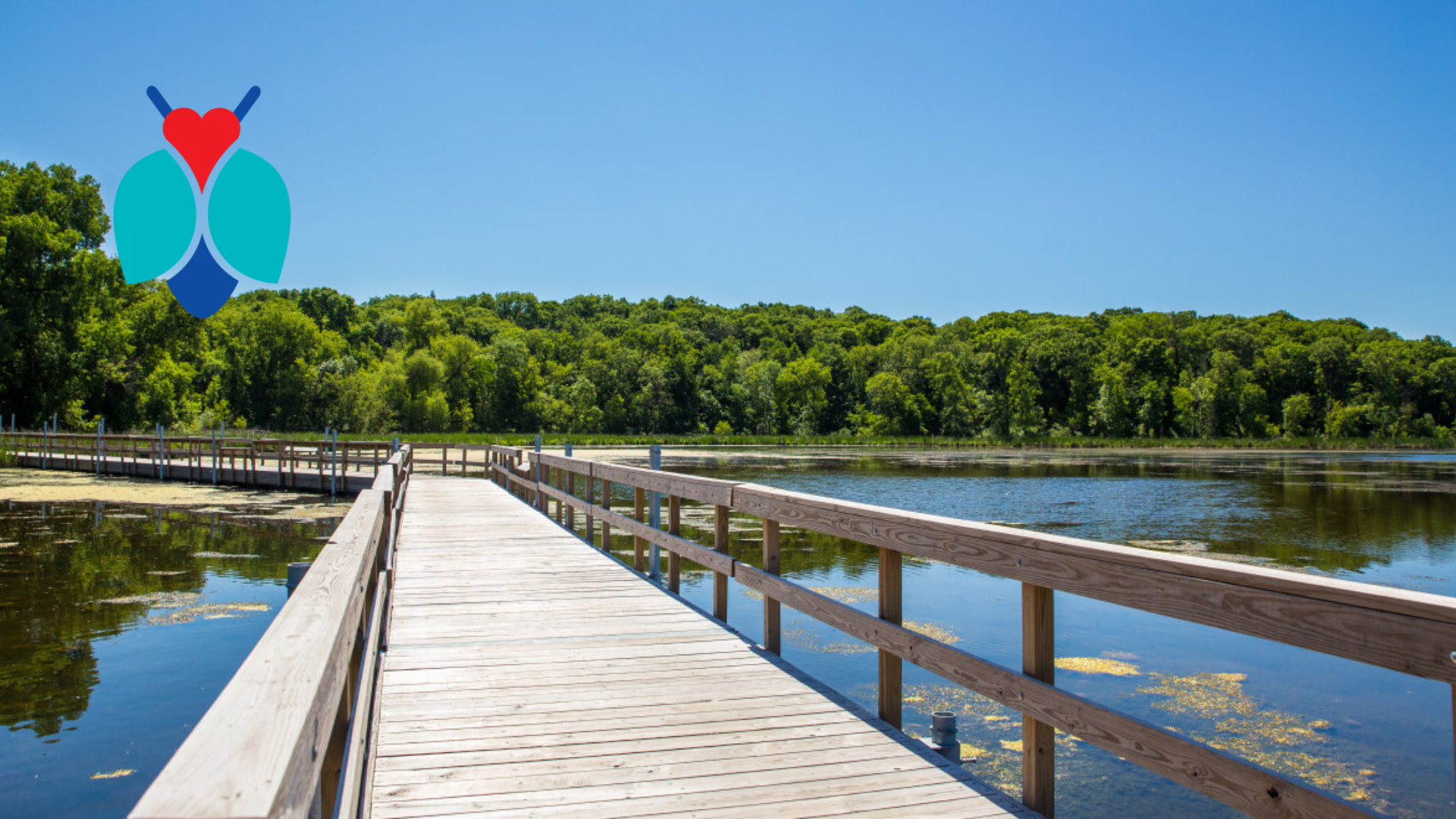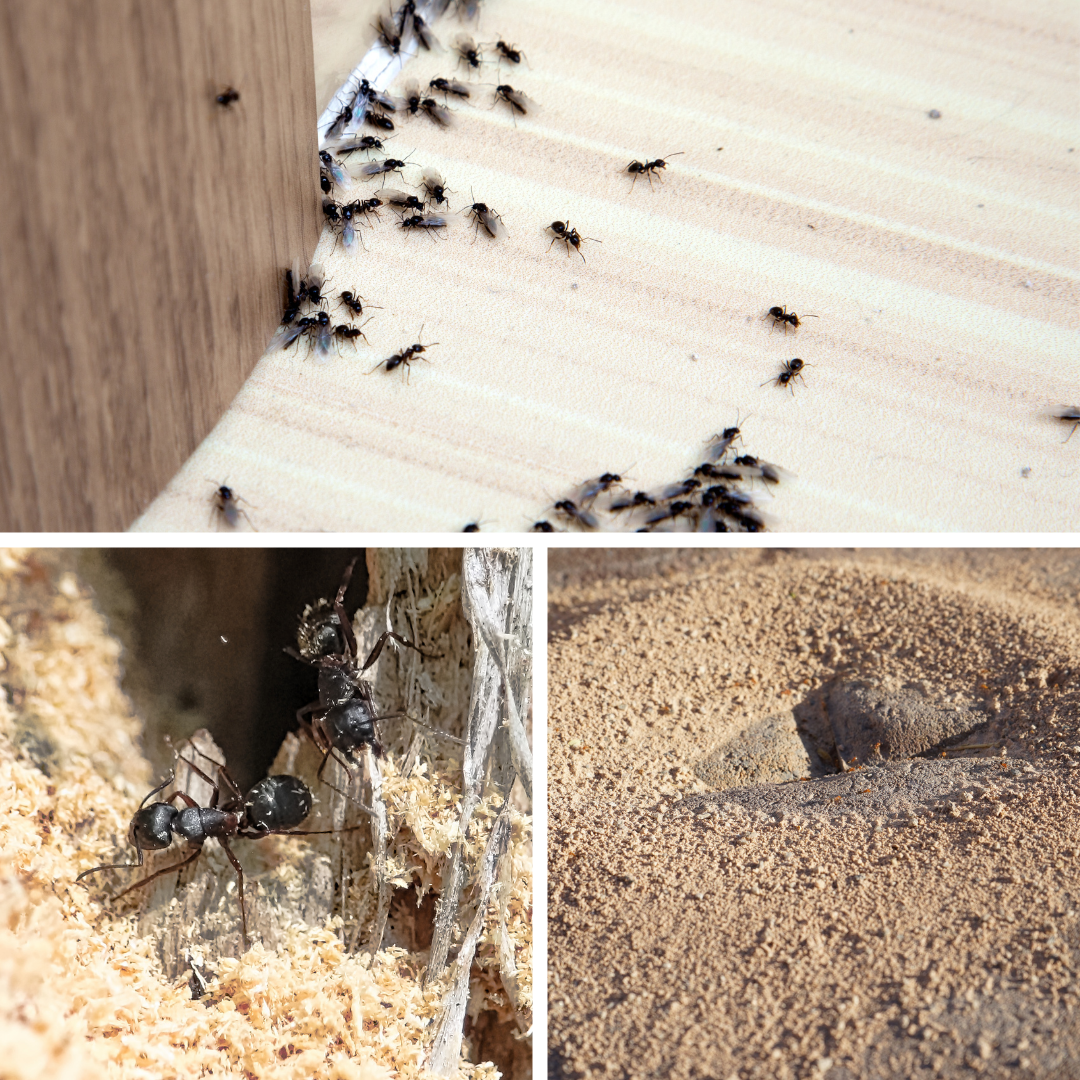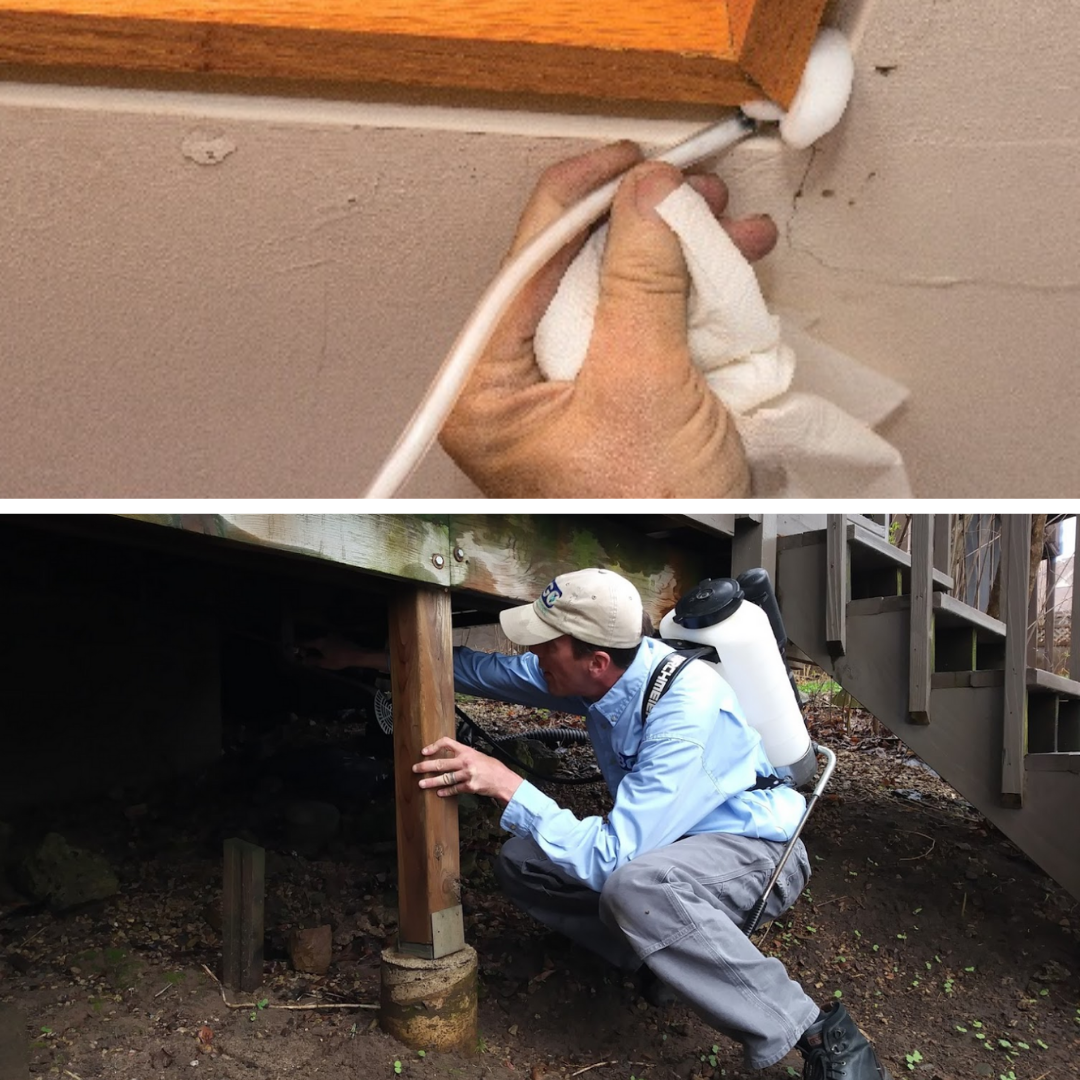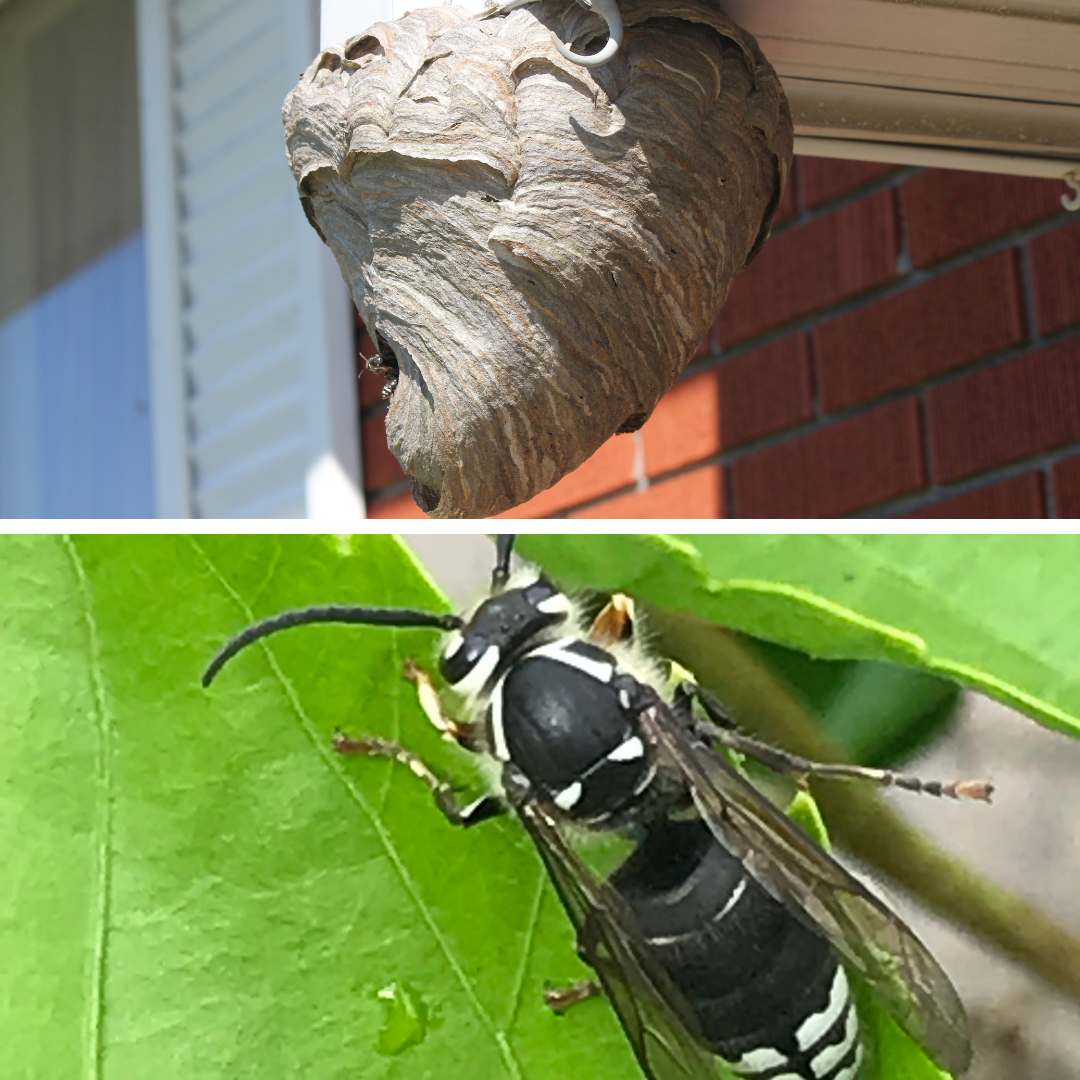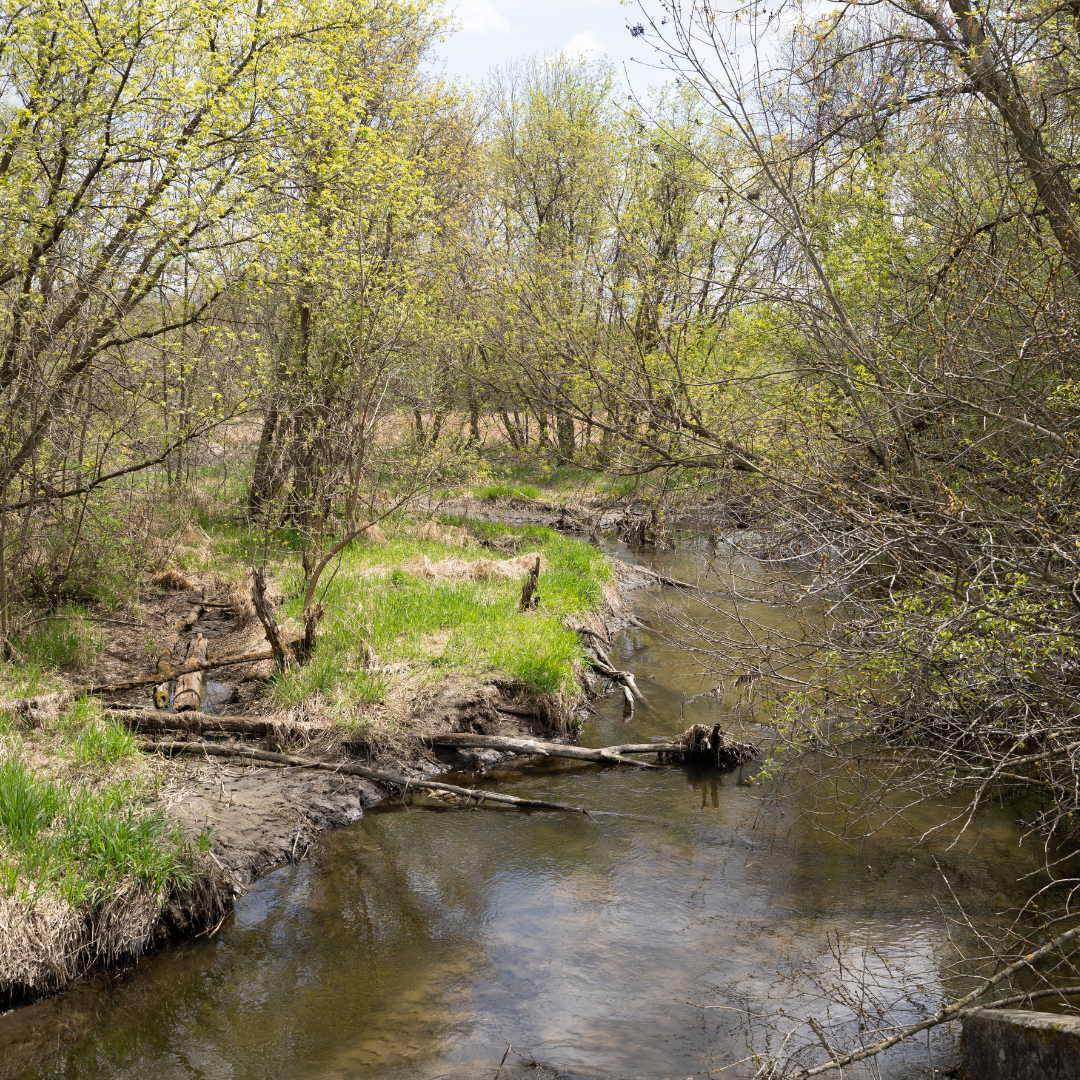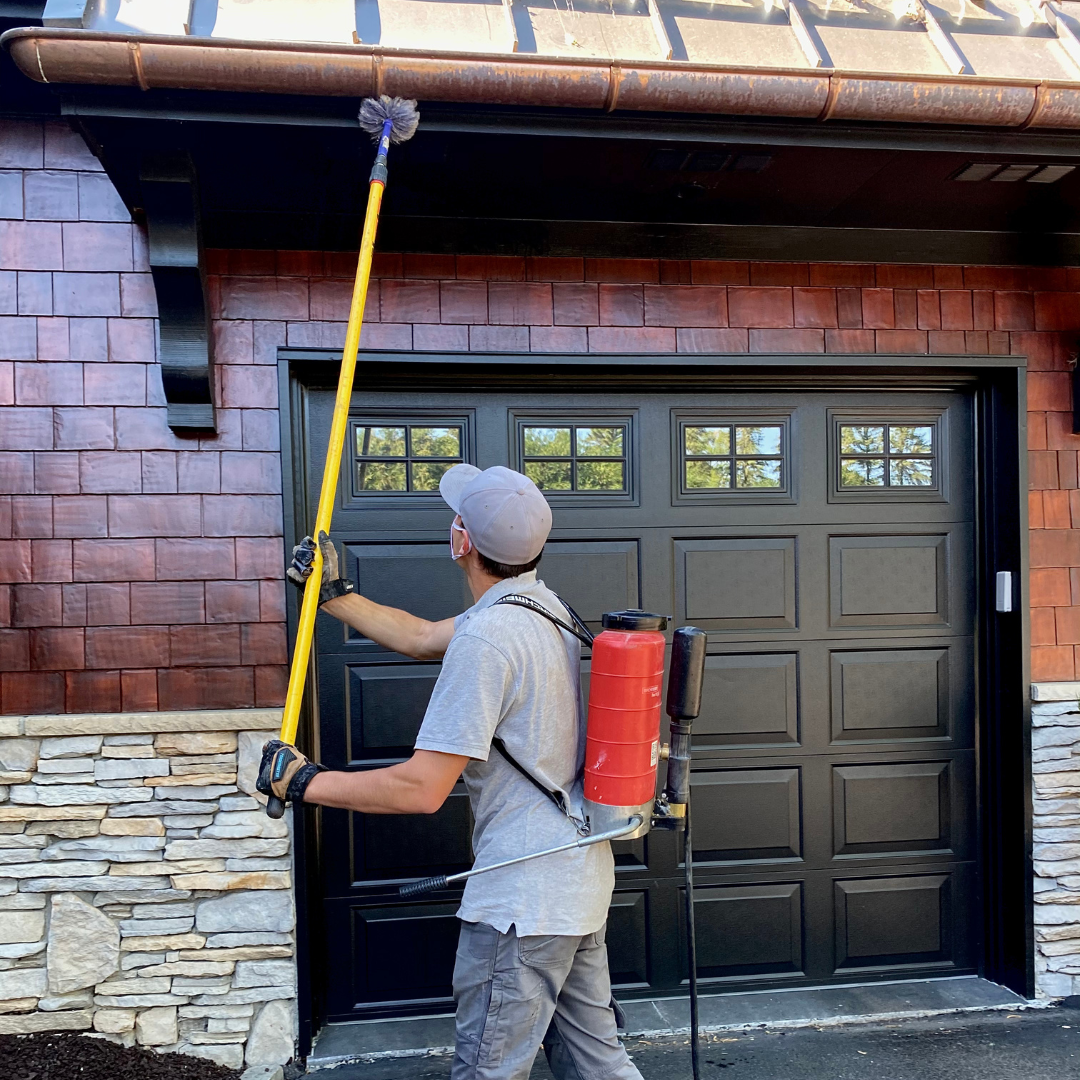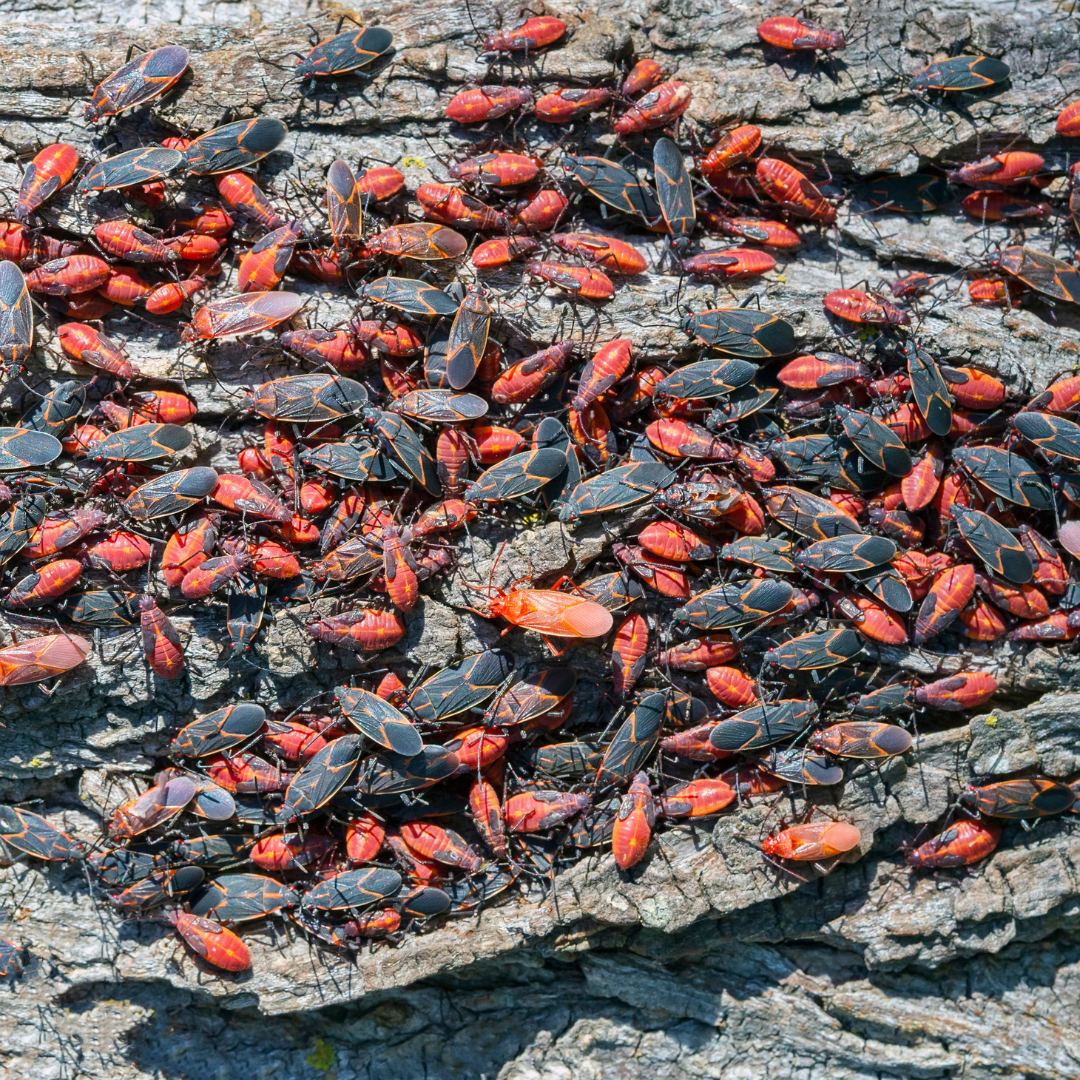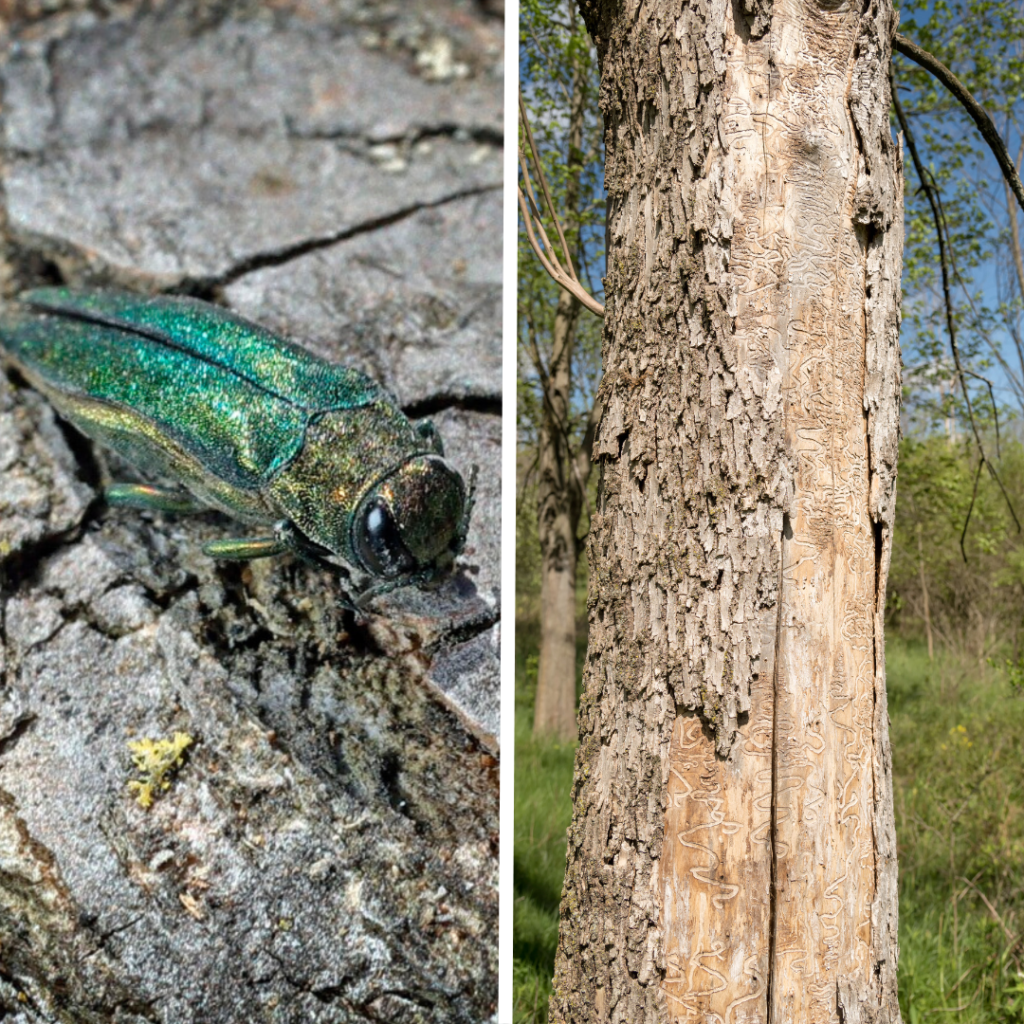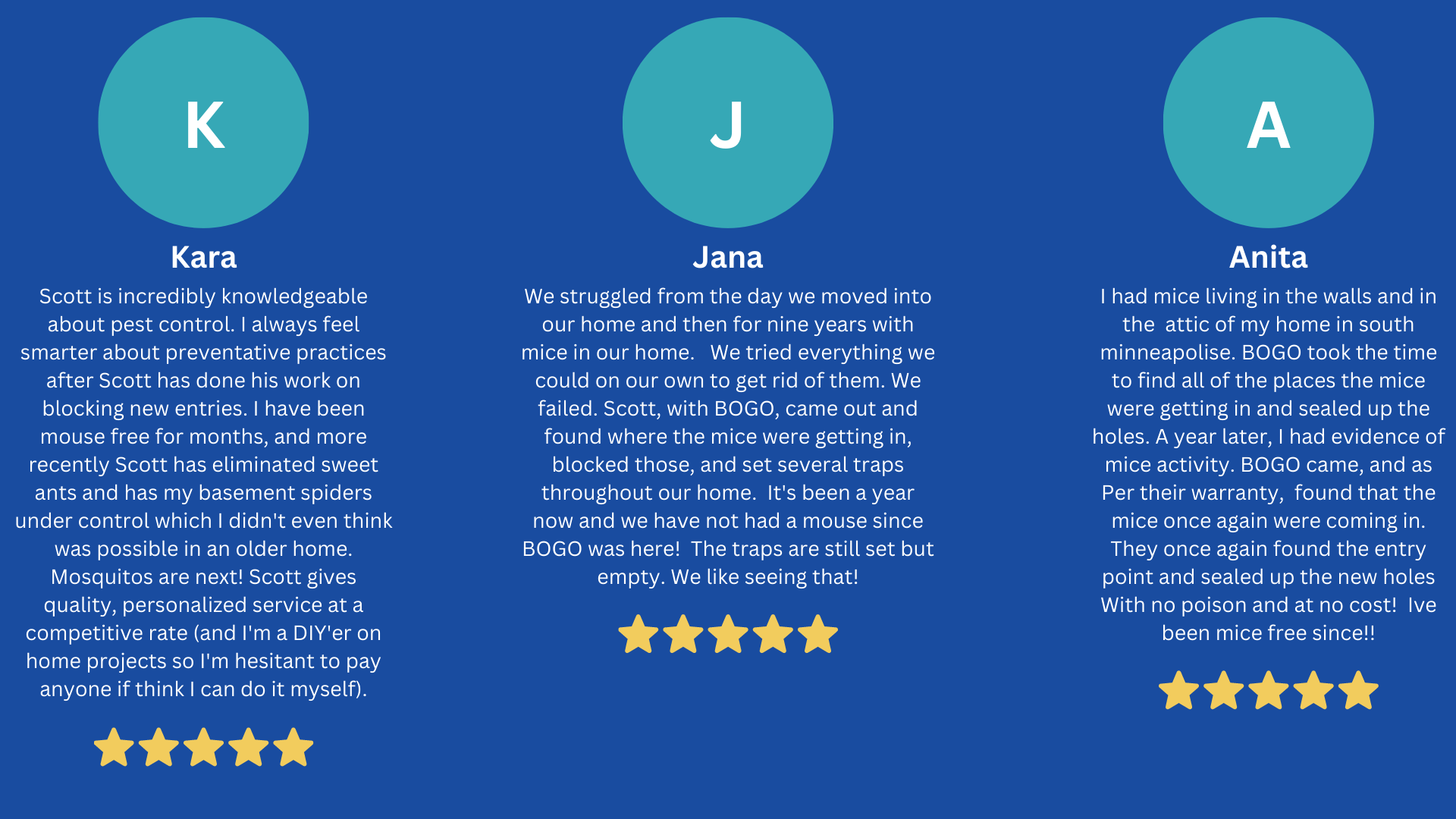Contact BOGO for all your St. Louis Park Minnesota Pest Control Needs
St. Louis Park is a city located in heart of Minneapolis. It’s a city in a great location close to downtown, lakes, and shops. People love it and pests do too.
These are the most common pests found in St. Louis Park Minnesota
(Click on the names to keep from scrolling)
To protect your home from all these insects and more our Insect Protection Plan or IPP is the best option
If you have any questions or concerns or would like to schedule an appointment call or send us an email
Call Us Today! 952-404-BOGO (2646)
Share This Page!
Ants in St. Louis Park Minnesota
Ant Behavior
Ants live in large social colonies where every ant is given a job that benefits the nest. For ants such as carpenter ants, their jobs consist of finding areas that contain wood that is rotted and wet. They build their nests inside rotted wooden structures by chewing small tunnels and galleries that hold their food, larva, and pupa. As they chew through the already damaged wood they leave piles of sawdust. The piles often have some of their food mixed in. Carpenter ants do not eat the wood like termites. Pavement ants most commonly build their nests underground. For instance under sidewalks, driveways, patios, and even inside homes. Their nests are easy to spot with circular sand mounds. Both ants share similar diets which include; insects, dog food, sugary foods, seeds, and occasionally oil/grease.
Ant Service
Our ant service is focused on eradicating the entire ant colony. Many ant killer products are marketed by showing customers piles of dead ants. This will not solve an ant problem. Only around 10% of ants in a colony leave the nest. When products kill only the ants that you see the problem will persist and potentially get worse. Ants that are living underground will notice fewer workers coming back with less food. To offset the dead ants the colony will send out more worker ants than before. Sometimes these ants even make brand-new nests in a safer areas. This effect is called budding and can make an ant problem much worse than it was before. Our professional-grade products allow the foraging ants to stay alive for some time before dying. This lets them bring the product back inside the nest where it quickly spreads. As the product spreads it will eventually reach the queen which will stop the ants from reproducing.
Click below to learn about our ant services
To learn more about ants visit our ant identification page
Mice in St. Louis Park Minnesota
Mouse Behavior
Mice are nocturnal creatures that do not hibernate in the winter and breed during every season of the year. Because mice are nocturnal they depend on their sense of smell more than their eyesight. They use their smell to follow scent trails made by other mice in their family group. A scent trail is essentially an invisible line made up of small droplets of urine. A mouse will pee every few inches while they’re walking so that other mice in their group know how to find their way back to their nest after roaming for food outside. Over time these scent trails can be visible on stucco and brick homes and along the foundation. These are called rub marks and indicate to techs that a home as had an on going mouse problem for quite a long time. Mice that live inside homes nest inside the insulation where it is warm and and gives them an opportunity to easily dig tunnels through it for storing food and baby mice.
Mouse Service
Other pest control companies either offer a monthly mouse plan service or a very expensive one-time service. These services are not designed to solve your mouse problem. They are designed to prolong it so that you continue to call them back and give them more money. Some of the most expensive quoted mouse jobs offer a product they say is mouse-proof insulation. This is not a real thing and will not keep mice from living in your attic or basement. The most effective way to get rid of a mouse problem is by sealing up the house from the outside using materials that are impossible for mice to chew through and are long-lasting. This is what BOGO uses and we have 100s of 5 star reviews backing up the quality and effectiveness of our work.
Click below to learn more about BOGO’s signature mouse service
To learn more about mice and their behavior visit our mouse identification page
Wasps in St. Louis Park Minnesota
Yellow Jackets
Yellow jackets are one of the most aggressive and feared wasps in Minnesota. These wasps do not lose their stingers after stinging someone. This means each yellow jacket can sting as many times as they want. Their nests grow to hold 1,000-4,000 wasps. As anyone can imagine disturbing a nest this large can turn into a big problem quickly. Their nest are often also well hidden and can vary in many different locations. They build them inside small cracks in the foundation, old underground rodent tunnels, papery aerial nests, and other places. Calling a professional pest technician is highly recommended to eradicate a yellow jacket nest.
Baldfaced Hornet
Baldfaced hornets have a unique appearance and build a unique nest. They’re colored cream white with black stripes. Their nests are easily distinguishable by there tear dropped shape. They are also always building an aerial nest that is at least 3 feet off the ground. Their nests can hold between 400-700 workers by the end of the summer. As their nests get to this size the workers become significantly more aggressive. Similar to yellow jackets they also can sting multiple times without losing their stingers and dying. Each nest dies at the end of the year and is not reused next spring.
Wasp Service
The products and tools we use for treating wasp nests are not accessible to buy over the counter. We use a product that can only be used by licensed pest control technicians. This product is extremally effective in eradicating large wasp nests by allowing the foraging wasps to bring the treatment back inside the nest before dying. As they bring the product back inside the nest they will spread it to all the worker wasps and eventually to the queen. Once the queen is dead the nest will die as there will be no way for the nest to reproduce and make more workers.
Click below to learn about our wasp services
To learn more about wasps and bees visit our identification page
Spiders in St. Louis Park Minnesota
Spider Behavior
Spider removal is the most common service call we receive in the spring and summer. Spiders induce a fear in people that is often unexplainable. With that fear, people often forget that spiders play an important role in our ecosystems. They keep the population of other insects from becoming overpopulated. Just a few of the insects they eat include; mosquitos, ticks, flies, and other aphids that transfer diseases to people and plants. Depending on the species of spider they each have their way of hunting for their food. There are web-building spiders and hunting spiders. Common web-building spiders include; the common house spiders, harvestmen spiders (aka daddy-longlegs), and garden spiders. They wait for the insects to come to them and capture them inside their webs. The most common hunting spiders include; wolf spiders, jumping spiders, and sac spiders. As their name suggests they go out and hunt for their food they usually go out and hunt at night.
Spider Habitat
Spiders live in areas that provide them with the most food. Meaning they enjoy living in areas that have large insect populations. When spiders are living inside they pick areas that are high in moisture. This includes basements, furnace rooms, laundry rooms, sub-pump rooms, etc. These rooms attract insects like ants, springtails, flies, earwigs, and many others. If there is a large spider population inside a home there is most likely another insect infestation happening at the same time. Going from the inside to the outside the same fact applies. Spiders pick to make nests and live in areas near bodies of water or wooded areas. These areas also attract many other insects giving them variety of insects to eat.
Spider Service
The spider service we offer is very effective. But unlike other pest control companies, we are transparent with customers about our expectations. Depending on the location of the homes we are treating. If a home is on or close to a body of water or in a wooded area then most likely one treatment will not suffice and after each service, it’s impossible to promise 100% of the spiders will die. There will always be spiders living outside. We tell all of our customers the product we use is only effective for about 2 months when sprayed on the exterior of the home. To have permanent protection the product needs to be reapplied.
Click below to learn about our Spider Service
To learn more about spiders read our blog “We Love Living Near Woods and Water and so do Spiders!”
Boxelder Bugs and Stink Bugs in St. Louis Park Minnesota
Boxelder Bugs
Boxelder bugs in the spring and summer live in female boxelder bug trees. These are the trees that produce helicopter seeds. They mate, lay eggs and their nymphs when born feed on juices inside the seeds. Their eggs are laid on the leaves, trunks, and branches of the trees. During the late summer and early fall, the boxelder bugs leave the trees in search of areas to over winter. They are often spotted on landing south-facing walls of homes and buildings where they can stay warm. Over time the start squeezing through small cracks in the foundation, siding, windows, and weather stripping to get inside to hibernate for winter. On sunnier winter days when the sun heats the roof, siding, and windows the bugs can be seen roaming around the inside. They are not breeding or laying eggs inside so the best option to get rid of them at that point is to use a vacuum.
Stink Bugs
Stink bugs are a pest that is invasive to America. There is still a lot that is not understood yet. They started appearing in Minnesota in 2010. At that time their population was much smaller than what it is today. The main reason for this is that there is still no current predator that eats the bugs. In the summer and spring, they spend most of their time inside agricultural fields where they breed and lay eggs on the top leaves and stems. They also feed on the crops. They have been seen damaging crops such as; sweet corn, grapes, apples, and tomatoes. Once temperatures start to drop the stink bugs start flying towards buildings and home to look for places to overwinter. Its been identified that stink bugs prefer to enter into homes through the attic or chimney.
Boxelder Bug and Stink Bug Treatment
Our boxelder bug and stink bug service is unique for a few reasons. First, it has to be applied in the fall. Second, it requires the majority of the exterior of the home to be covered with our product. The reason why we spray in the fall is that the insects start landing on the home in the fall. The service becomes more effective when the product is applied right before the swarms of bugs become visible. Once the bugs are already landing on the home there is already a population of bugs that made their way inside for winter. The reason we have to apply the product all over the house is that some bugs like boxelder bugs enter through the foundation and siding while stink bugs fly into soffits and chimneys to enter into the attic.
Click below to learn more about our boxelder/stink bug service
To learn more about boxelder bugs and stink bugs read our blog “Minnesota Fall Pests”
Ash Tree Service in St. Louis Park
Emerald Ash Borer Behavior
Adult emerald ash borers are relatively rare to see in the wild as they are mostly solitary insects. They find ash trees to lay their eggs on top of the bark. When the eggs hatch the larvae chew through the bark. The larvae live underneath the bark in the cambium layer of the tree. They feed on this layer of the tree which makes it difficult for the trees to spread nutrients and water to all their leaves and branches. Over time the highest branches in the canopy die first and eventually, the bark slowly starts to fall off. If half the canopy of the tree is dead its most likely too late to treat the tree.
Ash Tree Service
The ash tree service we provide does pneumatic micro-injections. Most other companies use treatment options that are not as effective. Other ash tree services inject or pour the product all at once. With our service, we measure the amount of product that goes into each injection point. This way product can spread evenly through the entire cambium layer. With other services, it’s impossible to know how much product one root took up compared to the others.
For more information about the emerald ash borer in Hennepin County
Learn more about the benefits of treating your ash trees
To protect your home from all these insects and more our Insect Protection Plan or IPP is the most effective option
BOGO Provides Pest Control Services For the Twin Cities and Beyond! Just a Few Cities We Service For Include;
Anoka|Apple Valley|Bloomington|Burnsville|Coon Rapids|Champlin|Chanhassen|Deephaven| Delano|Eagan|Eden Prairie|Edina|Elk River|Excelsior|Golden Valley|Independence|Lino Lakes|Long Lake|Maple Grove|Maple Plain|Medina|Minneapolis| Minnetonka|Minnetrista|Mound|New Brighton|North Oaks|Orono|Prior Lake|Plymouth|Ramsey|Rogers|Shoreview| Shorewood|Stillwater|St. Louis Park|St. Paul|Victoria|White Bear Lake| Wayzata|Woodbury|
(Click on the cities to learn about what pests to watch out for in your area)
If you have any questions or concerns or would like to schedule an appointment call or send us an email
Call Us Today! 952-404-BOGO (2646)



